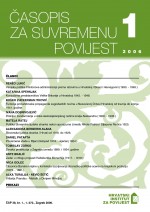Privremene vlade u Rijeci (listopad 1918. - siječanj 1924.)
Temporary Governments in Rijeka, October 1918 - January 1924
Author(s): Daniel PataftaSubject(s): History
Published by: Hrvatski institut za povijest
Keywords: Rijeka; Adriatic Question; Gabriele D'Annunzio; Rijeka auotnomists; fascism
Summary/Abstract: The state of Rijeka, which represented the last phase of the Rijeka question, was the compromise solution reached between the Kingdom of Serbs, Croats, and Slovenes and Italy at Rapallo in 1920. From the end of the First World War, due to national-political and economic reasons, especially because of domestic public pressure and the national movement among the Italians of Rijeka, Italy sought Rijeka for Italy. To start with, it utilized the newly proclaimed right to national self-determination and relied on the assistance of the Consiglio Nazionale delli Italiani di Fiume, the organization of Rijeka Italians. Together, they unseated the government of the National Council of the State of Slovenes, Croats, and Slovenes. Following the attack on French forces in Rijeka and the findings of the inter-allied investigating commission it seemed that Rijeka was going to be lost to Italy. But then Gabrielle D’Annunzio stepped onto the political-historical stage. He came to Rijeka with the quiet support of the Italian government, who used him to pressure the diplomatic representatives of the Kingdom of Serbs, Croats, and Slovenes. From the very beginning, the top political echelons of the Kingdom of Serbs, Croats, and Slovenes (the government in Belgrade and the supporters of a Greater Serbia) were disinterested in solving the Rijeka question to the benefit of Croatia, or indeed the Kingdom of Serbs, Croats, Slovenes. The Rapallo Agreement, which attempted to define the legal status of Rijeka, meant the end of D’Annunzio’s rule in Rijeka, who in a last desperate move proclaimed his Reggenza Italiana del Carnaro. After D’Annunzio was driven out of Rijeka, elections to the Constituent Assembly were held, but the formation of an autonomous government was prevented by a fascist coup. The Italian government took advantage of this coup to tie Rijeka more closely to Italy by obtaining political and economic privileges in Rijeka from Riccardo Zanelli, the leader of the Rijeka autonomists. Zanelli’s autonomous government was taken over by the second fascist coup, and from then until the annexation of Rijeka to Italy, the Italian government installed and removed governments in Rijeka in accordance with its interests. Since by 1924 Rijeka was de facto a completely Italianized city, economically and politically fully tied to Italy, the existence of the state of Rijeka became superfluous, thus the Rome agreements only legitimized the already existing status in Rijeka. By annexation Rijeka became a part of Italy, and was included in the newly established Provinzia del Carnaro. It was promptly forgotten and neglected by the new fascist government, and from a prosperous and wealthy city of international significance before the First World War it became a provincial harbour of the Kingdom of Italy. It suffered through a significant economic slump and stagnation in all spheres of social and economic life.
Journal: Časopis za suvremenu povijest
- Issue Year: 38/2006
- Issue No: 1
- Page Range: 197-222
- Page Count: 25
- Language: Croatian

